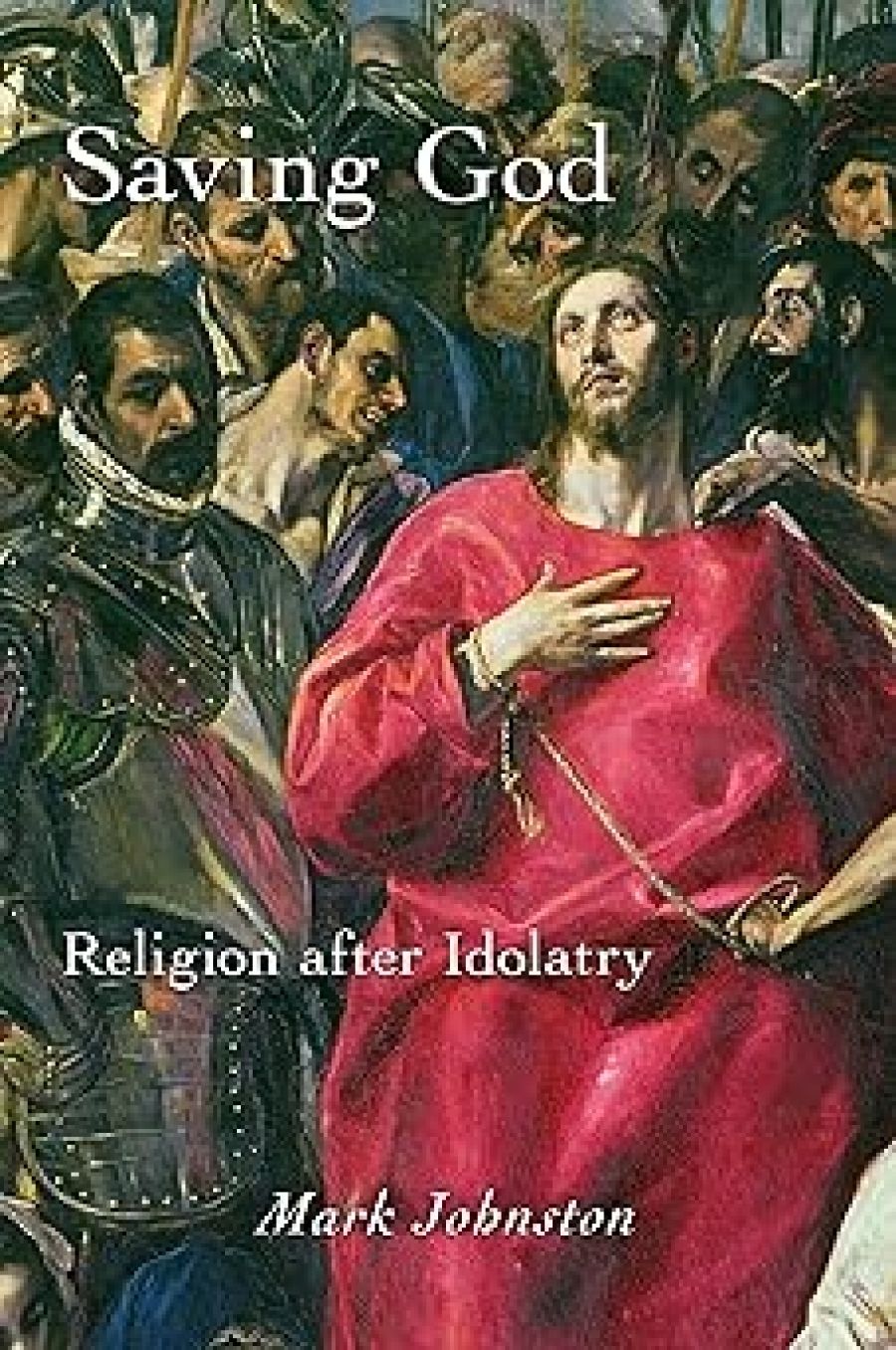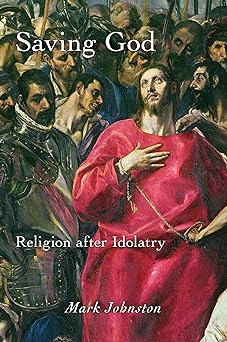
- Free Article: No
- Contents Category: Religion
- Review Article: Yes
- Article Title: Rescuing the Highest One
- Article Subtitle: Resisting ‘undergraduate atheists’
- Online Only: No
- Custom Highlight Text:
Mark Johnston’s Saving God: Religion after Idolatry is an astonishing book. Its surprise consists in its topic, style, passion, range of religious and philosophical scholarship, and its daring blend of human depth and philosophical originality. Johnston describes it as an essay that ‘gradually evolves into a sort of jeremiad’. There are plenty of complaints, and it is at times a tirade, especially in the final chapter, but the term ‘jeremiad’ does too little justice to the book’s subtlety and persuasive intelligence.
- Book 1 Title: Saving God
- Book 1 Subtitle: Religion After Idolatry
- Book 1 Biblio: Princeton University Press, $45.95 hb, 201 pp
- Book 1 Cover Small (400 x 600):

Analytic philosophers have an image problem with outsiders. They are thought to be desiccated pursuers of incomprehensible distinctions, apostles of the abstract, and nowadays dedicated promoters of ‘a scientific world view’ that has no serious place for the insights of art, literature, music and, of course, religion. There is some truth in this, but it is a distortion. For one thing, the last thirty or forty years have seen strong developments within the tradition in political philosophy, applied philosophy, aesthetics and philosophy of religion. They have also seen a certain broadening of perspective and a more adventurous approach to what ordinary people tend to think of as ‘the big questions’ of philosophy.
Certainly, Johnston doesn’t shirk them here. His topics are God, true religion, death, the afterlife and salvation. His aim is to save God and true religion from the gaggle of fashionably contemptuous sceptics, such as Richard Dawkins, Sam Harris, Christopher Hitchens and company, whom Johnston dismisses as ‘undergraduate atheists’. More importantly, he wants to save God from the vast number of religious believers whose attitudes to God are, he argues, idolatrous. So Johnston’s defence of God and religion will not please most adherents of mainstream religions and will probably confuse most atheists, who will be nonplussed by his attempt to naturalise religion while exalting God and endorsing a version of salvation through Christ.
Naturalism is at the heart of the book: for Johnston, the natural order is the only order there is, but its reality is not exhausted by the deliverances of the natural sciences. So he is equally opposed to scientism and supernaturalism, though the latter receives more persistent criticism and scorn. On scientism, he argues that the natural sciences tell us all we can hope to know about the causal order of the world (though what we come thereby to know centuries hence may be radically different from what we now think we know), but such knowledge is gained by a process of abstraction that leaves much else about our common, natural world to be understood. In particular, the abstraction and modelling that is fruitful in the physical sciences leaves untouched the manifest form (as Johnston calls it) of our activities, achievements and accomplishments. It also tells us nothing about the very intelligibility of the world that it explores, and it cannot speak to the nature and significance of what Johnston calls ‘the Highest One’,i.e. the God that is the putative object of the religious sense, at least as the major monotheisms dimly seek to attain it.
Johnston’s proclaimed methodology in the book is to use the religious sense, the scriptures and basic claims of the major religions, especially the three monotheisms, Judaism, Christianity and Islam, in a phenomenological spirit in order to reveal what a genuine religious quest might yield. This involves bracketing the existential claims involved in the traditions in order to explore what the most serious and consistent objects of religious experience could be. For Johnston, this exploration reveals a Highest One that presents itself as an object of veneration and provider of salvation, a conclusion that thus far would capture much that is central to the claims of monotheism. But he argues that the nature of such a Highest One is idolatrously misconstrued by much of the doctrine and theological elaboration of the monotheistic religions. Here, he deploys philosophical argument, theological analysis and scriptural exegesis to reject the ideas that God is somehow a Being separate from the natural world, that there is a life after death and that salvation requires it, and, with specific reference to Christianity, that Christ’s crucifixion was a sacrificial atonement. Instead, he argues for the positive replacement theses: that God is the natural order understood in a certain way, namely, as ‘the outpouring of Being by way of its exemplification in ordinary existents for the sake of the self-disclosure of Being’; that life after death is not only incoherent but stands in the way of a genuine understanding of salvation as ‘the grace of finding a way to live that keeps faith with the importance of goodness and love even in the face of everything that can happen to you’; that Christ’s life and death demonstrate the power of love and offer a path to the destruction of self-love and false righteousness.
There is much else to reward an attentive reader in this powerful book, such as the philosophical treatment of perception that serves as springboard for Johnston’s developing the account of God as self-disclosing Being, and the stern critique of the philosophical representational theories of mind that are so influential in cognitive science. There is also detailed engagement with, and critique of, Aquinas and Maimonides on the attributes of God and the borrowing of Aquinas’s theory of analogical predication for his own purposes. Johnston’s positive theory of perception is highly original and, surprisingly, owes some debt to the unlikely source of Martin Heidegger. Unfortunately, there is no room here to enter into the detail of these discussions.
Johnston’s philosophical hero in natural theology is Spinoza, though he wants to distinguish his position from Spinoza’s pantheism. (He is scathing about Hitchens’s enlistment of Spinoza in the cause of atheism.) He does this by invoking the theological tradition of panentheism which tries to keep the naturalism of pantheism but gives a transcendental twist to God via the idea that the Highest One is a process of self-disclosure of Being.
Johnston is conscious that his account of the religious sense and its proper objects will affront most of the devout, though he thinks that some of it is at least ‘incipient in their faith’. It is true that he gives a construal of many of the central concepts of monotheistic, especially Christian, faith, which finds some echoes in more orthodox sentiment and practice. Here, he is especially strong with the idea that (analogically) God is personal and loving and that the example of Christ is capable of transforming our natural tendencies to self-love and ‘false righteousness’. His theory, however, leaves little room for the centrality of prayer in the phenomenology of religion since most (especially intercessory) prayer will appear just as superstitious as so much else he jettisons. It would have been good to have more on this topic. I also suspect that the natural/supernatural dichotomy, which Johnston deploys to reject so much, needs more scrutiny in such debates.
The last chapter, on ‘Christianity without Spiritual Materialism’, is richly suggestive but rather rushed, and I found Johnston’s characterisation of the search for meaning in one’s life as ‘an inflated form of acquisitive desire’, and hence another piece of idolatry, quite unpersuasive. Nor is he sufficiently perspicuous about what exactly is ‘the false righteousness’ and ‘common and compromised conception of the good’ that the antinomian Christ has rightly come to destroy. After all, Christ said that he came to fulfil the law, not to destroy it, and his teaching of love of God and neighbour was meant to give the essence of the law. There are indeed compromised conceptions of the moral life, but ordinary decent morality need not embody them.
By the end of the book, the degree to which the phenomenological brackets are still in place remains somewhat unclear. Officially, Johnston is saying, ‘if there is a God, this is what he [it] must be and if Christ is his pre-eminent historical presence this is what he must have been about’. But the passionate conviction of the writing of the later chapters contains no such hypothetical tone. In any case, for the religious among us, this book provides an insightful, challenging and highly stimulating encounter. I can’t speak for the undergraduate atheists.


Comments powered by CComment